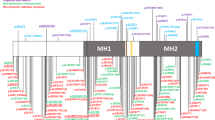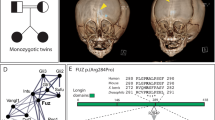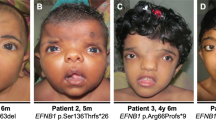Abstract
Jackson-Weiss syndrome is an autosomal dominant condition characterized by craniosynostosis, foot anomalies and great phenotypic variability. Recently mutations in fibroblast growth factor receptor 2 (FGFR2) have been found in patients with another craniosynostotic syndrome, Crouzon syndrome. FGFR2 is a member of the tyrosine kinase receptor superfamily, having a high affinity for peptides that signal the transduction pathways for mitogenesis, cellular differentiation and embryogenesis. We now report an FGFR2 mutation in the conserved region of the immunoglobulin Illc domain in the Jackson-Weiss syndrome family in which the syndrome was originally described. In addition, in four of 12 Crouzon syndrome cases, we identified two new mutations and found two previously described mutations in the same region.
This is a preview of subscription content, access via your institution
Access options
Subscribe to this journal
Receive 12 print issues and online access
$209.00 per year
only $17.42 per issue
Buy this article
- Purchase on Springer Link
- Instant access to full article PDF
Prices may be subject to local taxes which are calculated during checkout
Similar content being viewed by others
References
Jackson, C.E., Weiss, L., Reynolds, W.A., Forman, T.F. & Peterson, J.A. Craniosynostosis, midface hypoplasia, and foot abnormalities: an autosomal dominant phenotype in a large Amish kindred. J. Ped. 88, 963–968 (1976).
Van Herwerden, L. et al. Evidence for locus heterogeneity in acrocephalosyndactyly: a refined localization for the Saethre-Chotzen syndrome locus on distal cfttomosome 7p-and exclusion of Jackson-Weiss syndrome from craniosynostosis loci on 7p and 5q. Am. J. hum. Genet. 54, 669–674 (1994).
Reardon, W. et al. Mutations in the fibroblast growth factor receptor 2 gene cause Crouzon syndrome. Nature Genet. 8, 98–103 (1994).
Burgess, W.H. & Maciag, T., Maciag, T. The heparin-binding (fibroblast) growth factor family of proteins. A. Rev. Biol. chem. 58, 575–606 (1989).
Burgess, W.H. & Winkles, J.A. in Regulation of the proliferation of neoplastic cells (eds Pusztai, L, Lewis, C.EjHtep, E.) (Oxford University Press, Oxford, 1994).
Miyamoto, M. et al. Molecular Cloning of a novel cytokinec DNA encoding the ninth member of the fibroblast growth factor family, which has a unique secretion. Molec. cell. Biol. 13 4251–4259 (1993).
Jaye, M., Schlessinger, J., Dionne, C.A. Fibroblast growth factor receptor tyrosine kinases: molecular analysis and signal transduction. Biochim. Biophys. Acta 1135,185–199 (1992).
Givol, D. & Yayon, A. A complexity of FGF receptors: genetic basis for structural diversity and functional specificity. FASEB J. 6, 3362–3369 (1992).
Johnson, D.E. & Williams, L.T. Structural and functional diversity in the FGF receptor multigene family. Adv. Cancer Res. 60, 1–41 (1993).
Orr-Urtreger, A. et al. Develpmental localization of the splicing alternatives of fibroblast growth factor receptor-2 (FGFR2). Devel. Biol. 158, 475–486 (1993).
Shiang, R. et al. Mutations in the transmembrane domain of FGFR3 cause the most common genetic form of dwarfism, achondroplasia. Cell 78, 335–342 (1994).
Partanen, J. et al. FGFR-4, a novel acidic fibroblast growth factor receptor with a distinct expression pattern. EMBO J. 10, 1347–1345 (1991).
Li, X. et al. Two craniosynostotic syndrome loci, Crouzon and Jackson-Weiss, map to chromosome 10q23–26. Genomics 22, 418–424 (1994).
Preston, R.A. et al. A gene for Crouzon craniofacial dysostosis maps to the long arm of chromosome 10. Nature Genet. 7,149–153 (1994).
Dionne, C.A. et al. BEK, a receptor for multiple members of the fibroblast growth factor (FGF) family, maps to human chromosome 10q25.3→q26. Cytogenet. Cell Genet. 60, 34–36 (1992).
Senapathy, P., Shapiro, M.B. & Harris, N.L. Splice junctions, branch point sites and exons: sequence statistics, identifications and applications to genome project. Meth. in. Enzym. 183, 252–278 (1990).
Avivi, A., Yayon, A. & Givol, D. A novel form of FGF receptor-3 using an alternative exon in the immunoglobulin domain III.FEBS Lett. 330, 249–252 (1993).
Ullrich, A. & Schlessinger, J. Signal transduction by receptors with tyrosine kinase activity. Cell 61, 203–212, (1990).
Roussel, M.F., Downing, J.R. & Sherr, C.J. Transforming activities of human CSF-1 receptors with different point mutations at codon 301 in their extracellular domains. Oncogene 5, 25–30 (1990).
Miki, T. et al. Determination of ligand-binding specificity by alternative splicing: Two distinct growth factor receptors encoded by a single gene. Proc. natn. Acad. Sci. U.S.A. 89, 246–250 (1992).
Smith, L.M. et al. Fluorescence detection in automated DNA sequence analysis. Nature 321, 674–679 (1986).
Author information
Authors and Affiliations
Rights and permissions
About this article
Cite this article
Jabs, E., Li, X., Scott, A. et al. Jackson-Weiss and Crouzon syndromes are allelic with mutations in fibroblast growth factor receptor 2. Nat Genet 8, 275–279 (1994). https://doi.org/10.1038/ng1194-275
Received:
Accepted:
Issue Date:
DOI: https://doi.org/10.1038/ng1194-275
This article is cited by
-
Severe craniolacunae and upper and lower extremity anomalies resulting from Crouzon syndrome, FGFR2 mutation, and Ser347Cys variant
Child's Nervous System (2021)
-
Venous pathologies in paediatric neuroradiology: from foetal to adolescent life
Neuroradiology (2020)
-
Inherited FGFR2 mutation in a Chinese patient with Crouzon syndrome and luxation of bulbus oculi provoked by trauma: a case report
BMC Ophthalmology (2019)
-
An inherited FGFR2 mutation increased osteogenesis gene expression and result in Crouzon syndrome
BMC Medical Genetics (2018)
-
A de novo missense mutation of FGFR2 causes facial dysplasia syndrome in Holstein cattle
BMC Genetics (2017)



